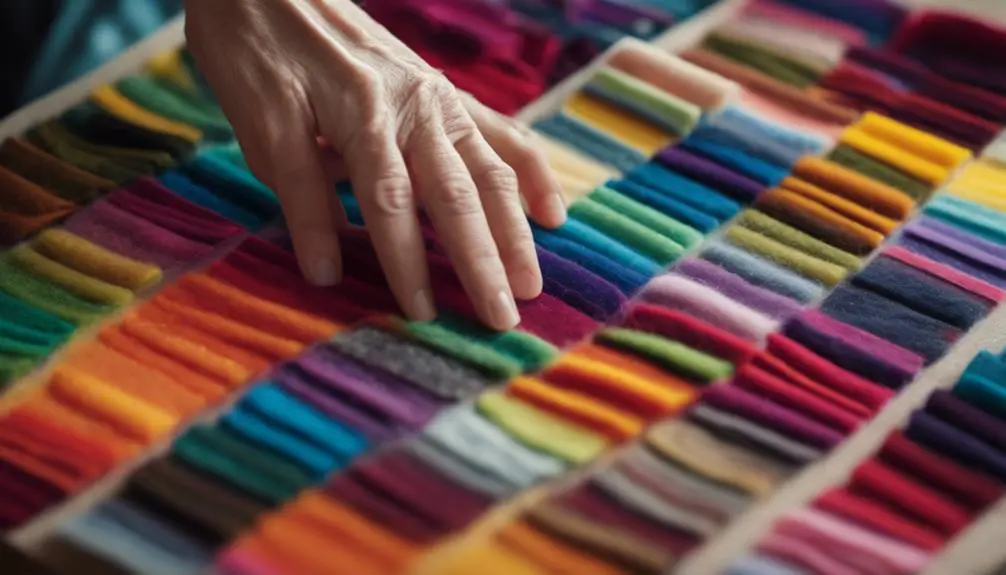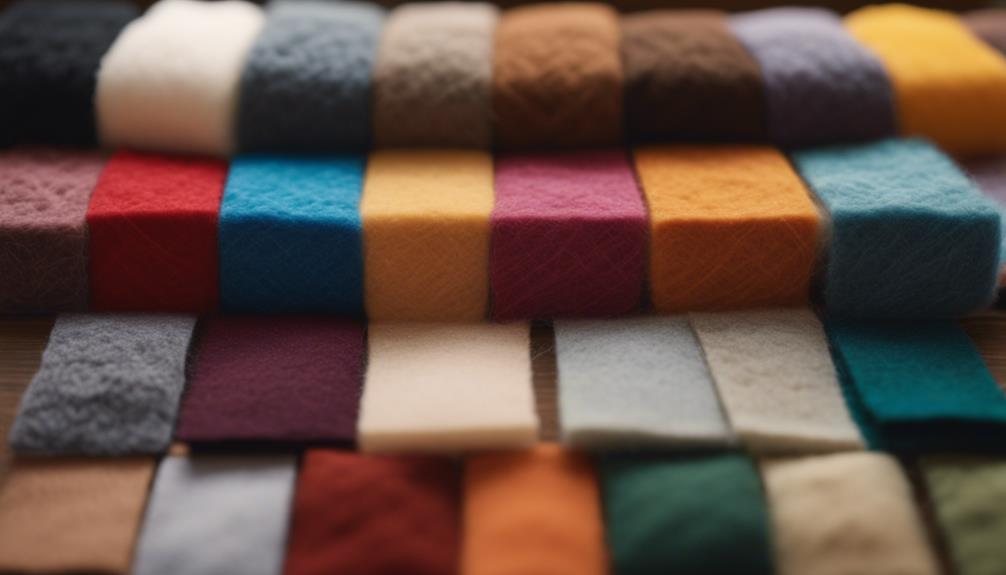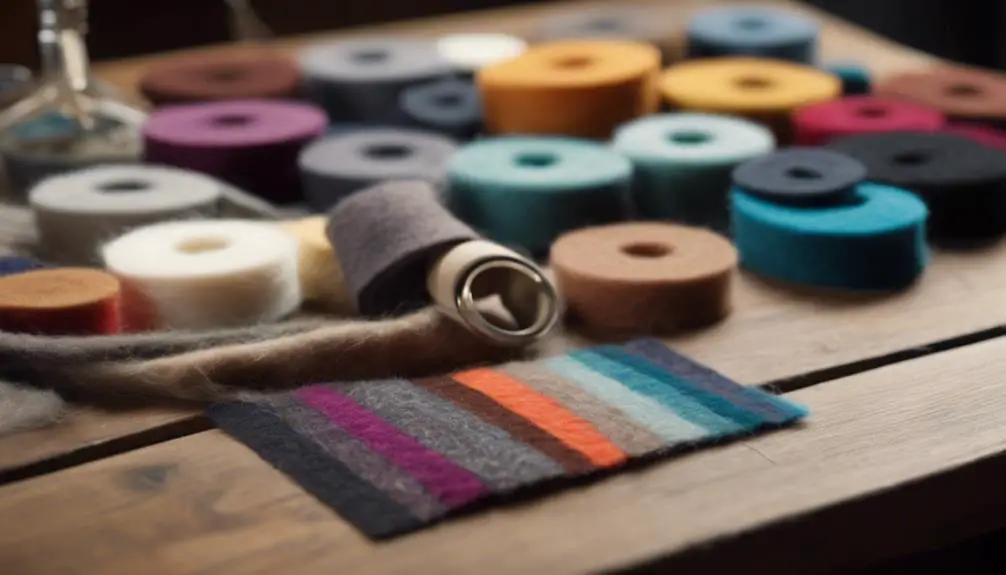You can identify felt by examining its texture, appearance, and density. Quality felt has a slightly bumpy surface, not smooth, and should feel solid when you manipulate it. Look for a shiny appearance, particularly with merino wool, which indicates proper felting. Check for uniformity; no visible lines or holes should be present. Press the felt firmly; if fibers move easily, it may need more processing. Verify it's completely dry to assess its true quality. By paying attention to these details, you'll enhance your craft projects, and there's plenty more useful information to explore further.
Understanding Felt Fabric

Felt fabric is a unique non-woven textile that's created by matting and pressing fibers together, primarily wool, though it can also include synthetic options like acrylic. This process involves heat, moisture, and pressure to interlock the fibers, making felt a durable and versatile material suitable for many applications.
When you're identifying felt, it's important to recognize the different types available. Wool felt is often your go-to choice due to its absorbent and insulating properties. It's perfect for projects needing warmth and durability. On the other hand, acrylic felt is a cost-effective alternative, though it tends to be less durable than wool felt. You might also encounter blended felts that combine both natural and synthetic fibers, offering a unique compromise regarding texture and functionality.
What makes felt stand out are its distinctive characteristics, including water resistance, lightweight nature, and sound dampening qualities. These features make it ideal for various uses, from rugs to insulation materials. Understanding these differences regarding types will help you choose the right felt for your next project.
Key Characteristics of Quality Felt
When selecting quality felt, you should look for several key characteristics that set it apart from inferior options. First, inspect the appearance; quality felt should have a uniform look without visible lines or holes, indicating proper integration of wool fibers. The surface texture is also important; a well-made felt will feel slightly bumpy rather than smooth, which can suggest poor quality.
Next, consider the drape and elasticity of the fabric. High-quality felt should produce a crisp sound when manipulated and shouldn't feel stiff or paper-like. If you're working with merino wool, the shine should reflect light effectively—dullness often points to inadequate felting processes.
Assessing Felt Readiness

To guarantee your felt is ready for use, it's crucial to examine its condition thoroughly. Start by allowing the felt to dry completely, as any moisture can mask imperfections and lead to poor quality. Once dry, inspect the surface for any bubbles or peeling, which indicate inadequate felting. These surface flaws can affect the overall durability of your felt.
Next, check the density by rubbing the felt to determine fiber movement. If the fibers shift easily, it suggests that further processing is needed to achieve a solid, cohesive fabric. Rolling and fulling the felt for an additional 5-10 minutes can enhance its quality and improve its density.
Avoid steaming or ironing the felt until after you've conducted a thorough inspection, as these actions can conceal initial problems. By carefully examining felt in this manner, you ascertain that you're working with a high-quality material that meets your needs. Remember, taking the time to evaluate its readiness will pay off in the long run, leading to better results in your projects.
Common Mistakes in Felt Identification
After ensuring your felt is ready for use, it's important to recognize common mistakes that can hinder your identification process. One major error is overlooking the drying process; wet felt can look different once dry, affecting its texture and integrity. Rushing through the rolling and fulling stages can compromise the density and durability of your felt, resulting in subpar finished products made from different types of materials, whether they're wool blend, synthetic felt, or recycled materials.
Another mistake is ignoring surface issues like bubbles or peeling after initial use. These flaws can signal that you didn't properly assess the felt quality before applying heat or finishing techniques. Miscalculating shrinkage during the felting process also impacts usability; this is especially significant for larger projects where fit matters. Finally, neglecting to check for layer movement during processing can lead to uneven felting. This results in poor quality felt that lacks the desired structural integrity, making it unsuitable for your intended use.
Visual Indicators of Felt Quality

Identifying quality felt involves keen observation of its visual characteristics. First, look for a smooth surface finish; quality felt is made with effective fiber integration, resulting in minimal irregularities. A shiny appearance is a good sign, indicating proper felting and good craftsmanship. Next, examine the edges. High-quality felt should have defined, consistent edges, steering clear of a melted look unless it's an intentional design choice.
Texture uniformity is another key factor. While quality felt may have a slightly bumpy texture, there shouldn't be any visible separation of fibers or surface irregularities. This uniformity reflects the care taken during the felting process.
After use, conduct a visual inspection for any signs of bubbles or peeling. These flaws can suggest insufficient fulling or improper processing, which detracts from the felt's overall quality. By paying close attention to these visual indicators, you can confidently identify quality felt and guarantee it meets your standards for craftsmanship and durability.
Practical Applications of Felt
Quality felt isn't just about how it looks; it's also about how you can use it in various practical applications. Felt is incredibly versatile, making it a favorite material for many projects. Whether you're crafting or tackling home improvement, you'll find felt available in various forms, including acrylic felt and wool with synthetic fibers.
Here are some practical applications of felt you might consider:
- Home Décor: Use felt for soundproofing and insulation; it's great for rugs, pads, and wall hangings.
- Fashion and Accessories: Create stylish bags, hats, and embellishments while showcasing its aesthetic appeal.
- Industrial and Medical Uses: Manufacturers use felt in machinery for filtration and insulation, while rayon felt serves hydrophilic functions in medical products.
Frequently Asked Questions
How to Identify Felt Fabric?
To identify felt fabric, check for a non-woven structure that doesn't fray. Look for a bumpy texture, smooth edges, and good elasticity. Quality felt drapes well and has a reflective surface, indicating proper crafting.
What Are 4 Characteristics of Felt?
When you examine felt, look for its non-woven structure, a smooth surface with no holes, a shiny appearance indicating good quality, and consistent, defined edges that reflect craftsmanship. These traits showcase felt's unique characteristics.
How Can You Tell the Difference Between Felt and Wool?
You can tell the difference between felt and wool by examining texture, smell, and structure. Felt feels denser and smoother, while wool is fluffier. Burning them reveals distinct odors, with wool smelling like burning hair.
What Is Considered Felt?
Felt's a non-woven fabric made from matted fibers, often wool or synthetics. You'll find it durable and versatile, perfect for crafting. Its unique structure prevents unraveling, setting it apart from woven materials you're familiar with.





Thanks to my father who stated to me on the topic of this webpage, this webpage is in fact amazing.
I think that what you typed was very logical.
But, think on this, what if you were to write a killer post title?
I ain’t saying your information isn’t good., but what
if you added something that makes people want more? I mean How to Identify Felt
– VCG is kinda plain. You should look at Yahoo’s front page
and note how they create article headlines to grab viewers to click.
You might add a video or a related picture or two to grab people interested about what you’ve written. In my opinion, it
could bring your posts a little livelier.